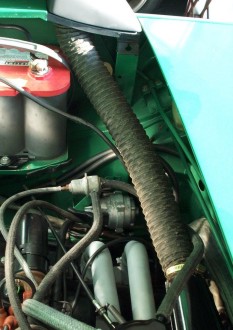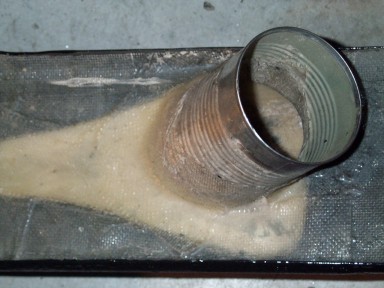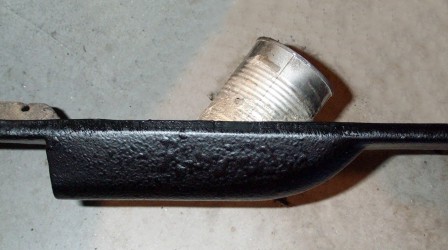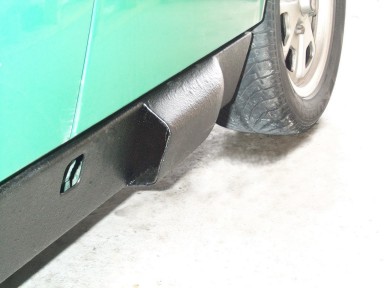| When I drive the car on the track, I have oil temperature problems...it
gets quite hot during a typical 25-minute session. I decided to investigate
this problem and see if I could devise a solution. Note that I had already
added an external oil cooler, with air pickup under the left, rear suspension.
Before I started, I bought a good 4-channel k-type thermocouple meter (an
Omega HH501DK). This was an essential tool.
I positioned thermocouples in various places on and around the engine
and drove the car to get temperature readings. I decided on a standard
30-minute, 28-mile roundtrip for these tests. It's a slightly hilly section
of rural farm-to-market road that is lightly traveled. I drove at a constant
70 MPH for the tests. I found several interesting things:
1. The air at the back of the engine compartment is much hotter
than the air at the front...about 15 degrees F higher! There are probably
several reasons: 1) the transmission, exhaust, and muffler are behind the
engine, plus, all the hot cooling air goes to the rear...all this heat
causes the sheet metal at the rear of the engine to be quite hot and it
heats the air inside the engine bay; 2) the engine mounted fan keeps air
moving across the front of the engine which keeps the air at the front
cooler. Since the inlet to the air cleaner is at the rear, the engine is
drawing in hot air. Even the air at the front of the engine compartment
is about 15 degrees F higher than ambient.
2. When I started, my baseline was an oil temperature rise of
142 degrees F above ambient. This seemed to be rather constant, regardless
of the ambient...over the short test range of about 75 to 105 degrees F.
Thus, when the ambient was 100 degrees F, the oil temperature was 242 degrees
F. Note that this was not really pushing the engine as on the track...it
was just a lazy drive in the country, at legal speeds!
3. Removing or opening the engine lid, resulted in a 4 degree
F improvement. I never tested removing the rain tray...it had been removed
years earlier. I'm sure it helps out a degree or two, but I don't have
any data...sorry.
4. Years earlier, I had substituted short air deflectors...these
are the soft plastic thingies that are attached to the body just in front
of the engine. These disrupt the air flow, making it turbulent and helping
extract heat from the engine. I replaced these with original deflectors
and noticed a 7 degree F improvement. These are quite important!
5. Moving the air pickup for the external oil cooler from under
the left, rear suspension to a NACA duct in the left rocker panel improved
the oil temperature 5 degrees F. I believe that the problem with the original
location was that some hot cooling air from the engine was spilling over
and entering the external oil cooler air inlet...the air flowing across
the rocker panel was cooler. But I suspected that this location for the
NACA duct might be less than optimal. They typically need to be mounted
in relatively uncluttered panels and not near an edge.
6. So I moved the air pickup for the external oil cooler from
the NACA duct to a 7 square inch scoop mounted outboard of the left rocker
panel. This reduced the oil temperature an additional 7 degrees from the
NACA duct setup.
7. I added a scoop to the right sail panel that ducted air to
the engine compartment. This improved the oil temperature 4 degrees F.
8. I extended the air inlet for the engine, by adding a duct that
picked up air from the right sail panel scoop. This improved the oil temperature
an additional 4 degrees F.
9. I changed the ignition timing from the nominal 27 degrees BTDC
to 35 degrees BTDC. This decreased the oil temperature 1 degree F.
In summary, by adding a right-side air scoop and sending part of this air
directly to the engine air cleaner, moving the air inlet for the external
oil cooler to a left-side scoop on the rocker panel, using the stock under-car
air deflectors, and increasing the ignition timing 8 degrees, I reduced
the oil temperature 30 degrees F.
| 





